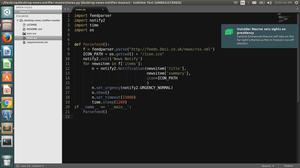20个极简Python代码,拿走即用

点击上方 Z先生点记,加为星标
第一时间收到 Python 技术干货!
学 Python 怎样才最快,当然是实战各种小项目,只有自己去想与写,才记得住规则。本文是 30 个极简任务,初学者可以尝试着自己实现;本文同样也是 30 段代码,Python 开发者也可以看看是不是有没想到的用法。
1重复元素判定
以下方法可以检查给定列表是不是存在重复元素,它会使用 set() 函数来移除所有重复元素。
def all_unique(lst):
return len(lst)== len(set(lst))
x = [1,1,2,2,3,2,3,4,5,6]
y = [1,2,3,4,5]
all_unique(x) # False
all_unique(y) # True
2字符元素组成判定
检查两个字符串的组成元素是不是一样的。
from collections import Counter
def anagram(first, second):
return Counter(first) == Counter(second)
anagram("abcd3", "3acdb") # True
3内存占用
import sys
variable = 30
print(sys.getsizeof(variable)) # 24
4字节占用
下面的代码块可以检查字符串占用的字节数。
def byte_size(string):
return(len(string.encode('utf-8')))
byte_size('') # 4
byte_size('Hello World') # 11
5打印 N 次字符串
该代码块不需要循环语句就能打印 N 次字符串。
n = 2
s ="Programming"
print(s * n)# ProgrammingProgramming
6 大写第一个字母
以下代码块会使用 title() 方法,从而大写字符串中每一个单词的首字母。
s = "programming is awesome"
print(s.title())# Programming Is Awesome
7分块
给定具体的大小,定义一个函数以按照这个大小切割列表。
from math import ceil
def chunk(lst, size):
return list(map(lambda x: lst[x * size:x * size + size],list(range(0, ceil(len(lst) / size)))))
chunk([1,2,3,4,5],2)
# [[1,2],[3,4],5]
8压缩
这个方法可以将布尔型的值去掉,例如(False,None,0,“”),它使用 filter() 函数。
def compact(lst):
return list(filter(bool, lst))
compact([0, 1, False, 2, '', 3, 'a', 's', 34])
# [ 1, 2, 3, 'a', 's', 34 ]
9解包
如下代码段可以将打包好的成对列表解开成两组不同的元组。
array = [['a', 'b'], ['c', 'd'], ['e', 'f']]
transposed = zip(*array)
print(transposed)
# [('a', 'c', 'e'), ('b', 'd', 'f')]
10 链式对比
我们可以在一行代码中使用不同的运算符对比多个不同的元素。
a = 3
print( 2 < a < 8)
# True
print(1 == a < 2)
# False
11 逗号连接
下面的代码可以将列表连接成单个字符串,且每一个元素间的分隔方式设置为了逗号。
hobbies = ["basketball", "football", "swimming"]
print("My hobbies are: " + ", ".join(hobbies))
# My hobbies are: basketball, football, swimming
12 元音统计
以下方法将统计字符串中的元音 (‘a’, ‘e’, ‘i’, ‘o’, ‘u’) 的个数,它是通过正则表达式做的。
import re
def count_vowels(str):
return len(len(re.findall(r'[aeiou]', str, re.IGNORECASE)))
count_vowels('foobar')
# 3
count_vowels('gym')
# 0
13 首字母小写
如下方法将令给定字符串的第一个字符统一为小写。
def decapitalize(string):
return str[:1].lower() + str[1:]
decapitalize('FooBar')
# 'fooBar'
decapitalize('FooBar')
# 'fooBar'
14 展开列表
该方法将通过递归的方式将列表的嵌套展开为单个列表。
def spread(arg):
ret = []
for i in arg:
if isinstance(i, list):
ret.extend(i)
else:
ret.append(i)
return ret
def deep_flatten(lst):
result = []
result.extend(spread(list(map(lambda x: deep_flatten(x) if type(x) == list else x, lst))))
return result
deep_flatten([1, [2], [[3], 4], 5])
# [1,2,3,4,5]
15 列表的差
该方法将返回第一个列表的元素,其不在第二个列表内。如果同时要反馈第二个列表独有的元素,还需要加一句 set_b.difference(set_a)。
def difference(a, b):
set_a = set(a)
set_b = set(b)
comparison = set_a.difference(set_b)
return list(comparison)
difference([1,2,3], [1,2,4]) # [3]
16 通过函数取差
如下方法首先会应用一个给定的函数,然后再返回应用函数后结果有差别的列表元素。
def difference_by(a, b, fn):
b = set(map(fn, b))
return [item for item in a if fn(item) not in b]
from math import floor
difference_by([2.1, 1.2], [2.3, 3.4],floor)
# [1.2]
difference_by([{ 'x': 2 }, { 'x': 1 }], [{ 'x': 1 }], lambda v : v['x'])
# [ { x: 2 } ]
17 链式函数调用
你可以在一行代码内调用多个函数。
def add(a, b):
return a + b
def subtract(a, b):
return a - b
a, b = 4, 5
print((subtract if a > b else add)(a, b))
# 9
18 检查重复项
如下代码将检查两个列表是不是有重复项。
def has_duplicates(lst):
return len(lst) != len(set(lst))
x = [1,2,3,4,5,5]
y = [1,2,3,4,5]
has_duplicates(x)
# True
has_duplicates(y)
# False
19 合并两个字典
下面的方法将用于合并两个字典。
def merge_two_dicts(a, b):
c = a.copy() # make a copy of a
c.update(b) # modify keys and values of a with the once from b
return c
a={'x':1,'y':2}
b={'y':3,'z':4}
print(merge_two_dicts(a,b))
#{'y':3,'x':1,'z':4}
在 Python 3.5 或更高版本中,我们也可以用以下方式合并字典:
def merge_dictionaries(a, b)
return {**a, **b}
a = { 'x': 1, 'y': 2}
b = { 'y': 3, 'z': 4}
print(merge_dictionaries(a, b))
# {'y': 3, 'x': 1, 'z': 4}
20 将两个列表转化为字典
如下方法将会把两个列表转化为单个字典。
def to_dictionary(keys, values):
return dict(zip(keys, values))
keys = ["a", "b", "c"]
values = [2, 3, 4]
print(to_dictionary(keys, values))
#{'a': 2, 'c': 4, 'b': 3}
推荐阅读:
有码变高清!AI一秒还原马赛克
全球最厉害的 14 位程序员,你认识几位?
本文分享自微信公众号 - Z先生点记(gh_683d048a482a)。
如有侵权,请联系 support@oschina.cn 删除。
本文参与“OSC源创计划”,欢迎正在阅读的你也加入,一起分享。
以上是 20个极简Python代码,拿走即用 的全部内容, 来源链接: utcz.com/z/509065.html




